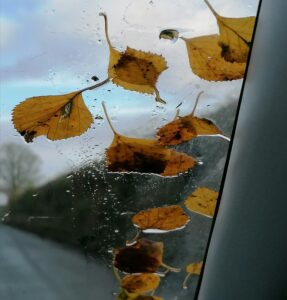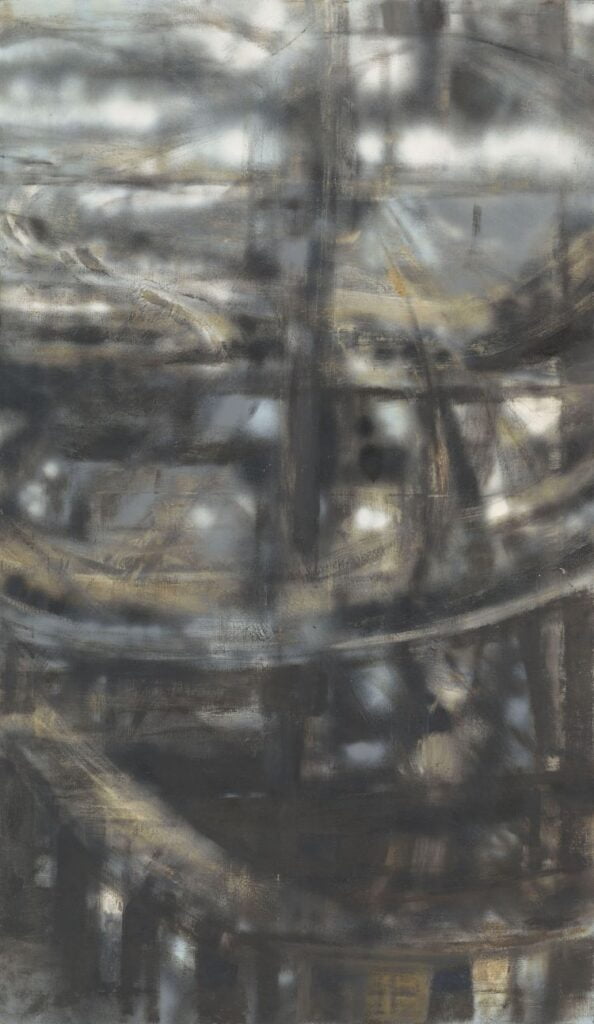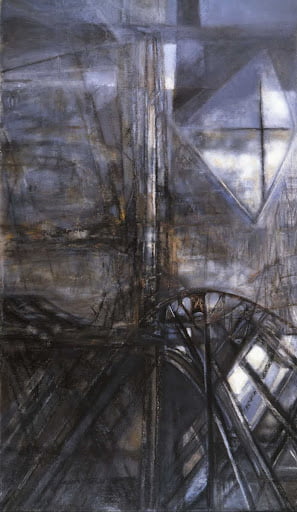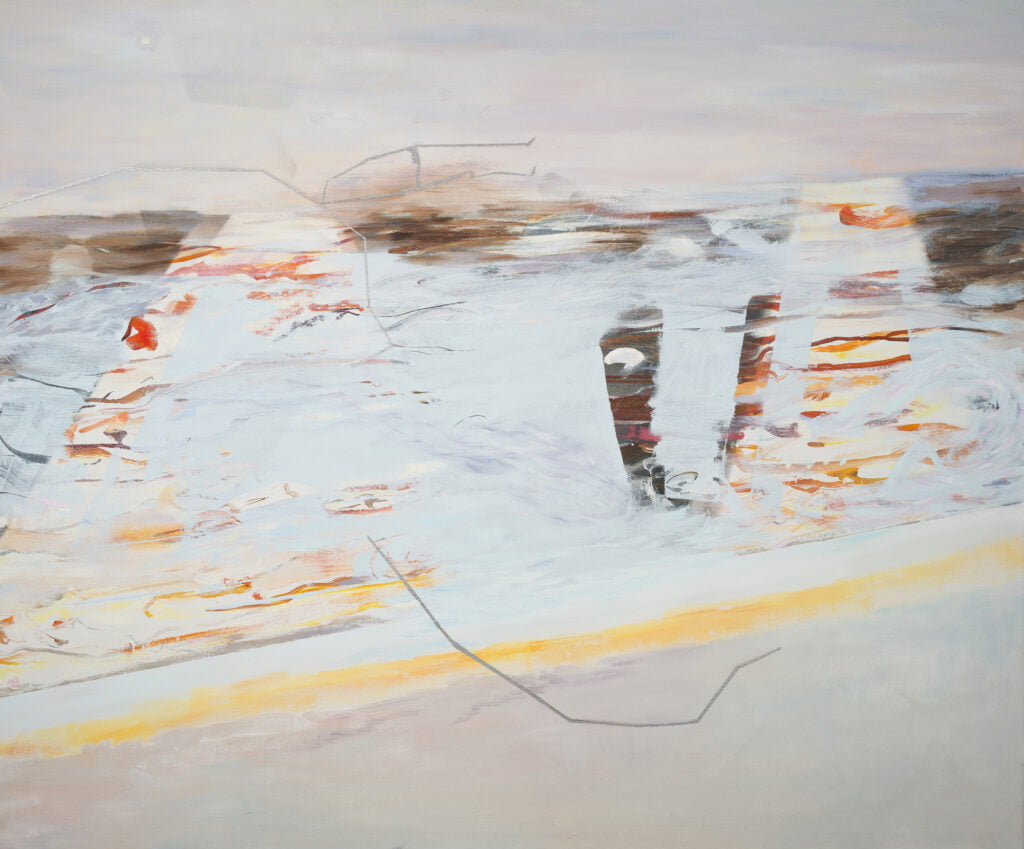Hedda Sterne used spray paint for many of her works (particularly the New York series made in the ’50s). My approach to this research is practice based, I am taking a lead from Hedda’s philosophy and ideas as well as from her studio processes. With that in mind I ordered some acrylic spray paint and have started scribbling down (and keeping) my own ‘studio notes’. Usually on random snippets of paper – I suppose they are an informal record of my progress in the studio. One of the first lines here:
‘and then I pick up a spray can and the process really begins
nothing like spraying cadmium red to make you bounce inside…’

In the 1950s spray paint was a new invention, just appearing in hardware stores, and she was I believe the first artist at the time to use the new Rustoleum paint to make works of art. She took up the spray can and fearlessly divided her canvases with bold composition lines. Diving into painting her experiences of New York with the vigour and vitality of a person relishing their environment. She was fascinated by the city – the cultural differences of course, but also the layered complexity of its railways and elevations.
There is something very exciting about taking a spray can to canvas. It feels brave and bold (empowering even?). Lines have to be decisive and fast…spray cans are not for the faint hearted. Their speed and defiant attitude are at odds with the beautiful soft fuzzy edges and hazy effects they can create. Likewise there is a satisfying opposite in spending time masking. It is very time consuming, like making a drawing with tape – strangely precise and annoyingly sticky at times. This laying of preparations for a rapid flash across with a veil of spray is performative in its way. Deceptively rapid and entirely appropriate as the best way to evoke the speed and power of the city.
I have also started writing notes about paintings. Writing thoughts down seems to make me consider them more. Writing, even if it’s just noting down the way you are looking, employs a different type of thinking than drawing. I know it sounds a bit ridiculous, but bringing more writing into the studio mix is new to me. I am finding it fascinating.
Hedda wrote about New York as being in constant motion:
‘Lines approaching swiftly and curving back again forming an intricate ballet of reflections and sounds’
Some notes here on two of her paintings from this series.
New York VIII’, Hedda Sterne, 1954.
Synthetic Polymer Paint on Canvas 72 1/8 x 42 in. Museum of Modern Art, New York.
A seemingly fragile structure. Swift lines – vertical (almost central) and horizontal divisions with dynamic arcs taking the viewer into and through the painted space. There is a sense of being underneath a bridge. Girders and spaces are suggested. Some open up only as you spend time looking…then the brighter blurred highlights step forward and take centre stage. Stepping out of the shadows, they have a conversation of their own on a plane in front of the rest. Getting brighter to the top and lighter until eventually blobs and dots of light become more like waves.
In the top segment they seem to set the whole painting in motion. Like skittles tumbling. The movement swings round and takes us on a whirlwind tour back down and round and through the layers, until we are delivered back to the ground. Then your eye starts to go back in… this time tracking a route in the shadows and blackest spaces. The second journey deals in negative spaces and subtext. It is almost as though you are in a glass elevator, moving upwards and all the time your eyes drawn to the horizon beyond. The multiple distances and sense of levels is offset by shifts in pace and direction. Half way to being a painterly fairground ride.
‘New York 1’,Hedda Sterne, 1954
Oil on Canvas. 86 3/16 x 50 1/4 in. Toledo Museum of Art
Dynamic drawing. Strong lines and a cinematic drama are the first things to hit me. A small ledge at the base of the painting offers a beginning. If you choose to step there your eye is drawn upwards. That bottom third of the painting has a looming scale and claustrophobic sense of tall buildings towering above you. The bright lights which seem to be windows – until they’re suddenly diamonds – take your eye. They emphasise the strength of built environment on all sides.
Then you reach the curving snake of an intersecting structure. Triangular pockets of sky are there between the iron spars and as you notice these ‘negative spaces’ that is when the magic starts to happen. Light projections appear, illuminating the space above. Like a ‘son et lumiere’ the central line seems to link the beneath and above sections. We might simply be positioned at the side elevation of a bridge, but our position oscillates – from the street view to a hovering mid-air state – and then upwards and out beyond and across a space criss-crossed by large spectral cross hatchings….and still further up to the enlarged echo shapes which seem to be visual reverberation. They hold and anchor the composition very cleverly, never lapsing into pattern. They hold their own. Definite, clear and ambiguous all at once.
A beautiful soft section of subtle greys, blues and whites held within an uneven diamond holds the eye; briefly magnifies the structure below and suddenly when you glance beneath you are looking down onto those girders. The delicate complex under drawing starts to show itself now – a thrilling puzzle for the eye. Diagonals and triangular shapes pushing and pulling across space and all of this within a feeling of night time. A city nocturne. Both daring and dynamic the central line manages to unite not divide. A bold compositional statement- it serves as a lynch pin for the zigzag pushes and pulls which are set in motion once you really engage with the painting.
Taken together these two paintings offer an interesting look at Hedda’s use of spray paint. The first (New York VIII) is executed solely with a spray can and is by far the more painterly of the two. It is as though the pace that the spray insisted on allowed her to really let rip with the possibilities of speed in painting. She seems to be choreographing the lines through and around her painted spaces, loosening her control and allowing the blurs to zoom by at will. This is a thrilling idea. The second ( New York 1) uses just oil paint and relies on it’s strength of drawing and dynamic composition rather than gestural marks or fuzzy suggestions. Amazing to note that they were painted in the same year. You can see how her use of spray paint directly results in a leap forward in her thinking.
‘The First League Out From Land’, Alison Critchlow 2021
Oil, Acrylic and Spray Paint on Canvas 120 x100 cm
My recent paintings employ combinations of spray paint, oil, acrylic, charcoal and ink, made with under-painted sections and masking in layers, new techniques to me, which bring interesting changes of pace. They are already leading onto new thinking and experiments. Hedda Sterne’s influence is exerting itself.
A few studio photos and close up details of works in progress here.











![IMG 20211130 175629 Resized 20211207 034700533[1728]](https://www.alisoncritchlow.co.uk/wp-content/uploads/2022/01/IMG_20211130_175629_resized_20211207_0347005331728-800x480.jpg)
